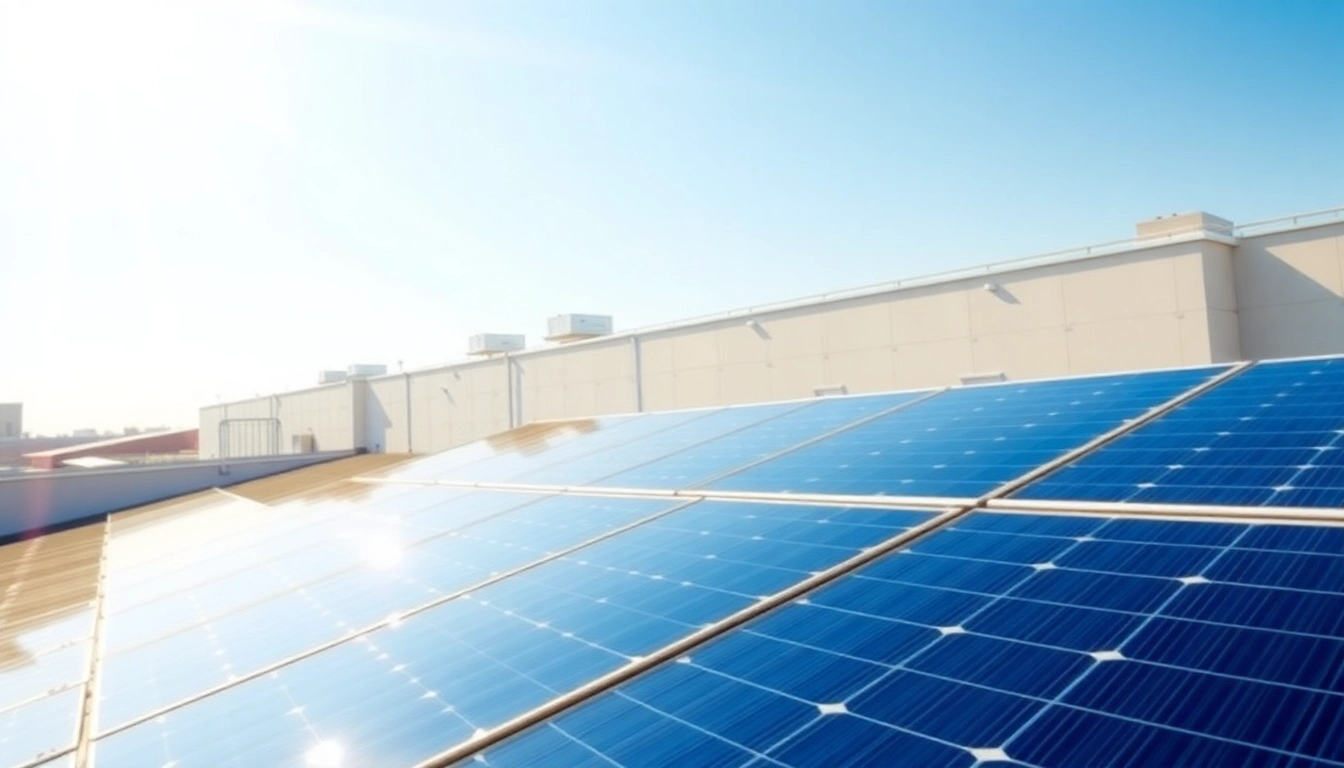Understanding Commercial Solar Energy
As businesses around the world strive for sustainability and energy efficiency, commercial solar solutions have emerged as a powerful alternative to traditional energy sources. By harnessing the sun’s abundant energy, commercial solar systems not only reduce reliance on fossil fuels but also help organizations lower operational costs and increase energy independence. In this article, we explore the various dimensions of commercial solar energy, from its fundamental concepts to the future of this rapidly evolving sector.
What is Commercial Solar?
Commercial solar refers to solar energy systems specifically designed for businesses, organizations, and municipal buildings. Unlike residential solar systems, which typically serve homes, commercial installations can vary significantly in scale and complexity, ranging from rooftop solar panels on a small storefront to extensive ground-mounted arrays serving large industrial facilities.
Essentially, commercial solar systems convert sunlight into electricity through photovoltaic (PV) cells. These systems can produce energy to power lighting, heating systems, machinery, and all the electrical appliances within commercial properties. Businesses can install different types of solar arrangements such as grid-tied systems, which connect to the local utility grid, or off-grid systems that operate independently.
Benefits of Commercial Solar Systems
Investing in commercial solar energy offers several tangible benefits:
- Cost Savings: The most compelling reason for businesses to adopt solar technology is to reduce electricity costs. By generating their own energy, companies can save significantly on utility bills. In many cases, the return on investment for solar installations comes within a 3- to 7-year period.
- Tax Incentives: Various federal and state incentives exist for commercial solar installations. The Investment Tax Credit (ITC) allows businesses to deduct a significant percentage of the total installation cost from their federal taxes, making solar investment even more financially appealing.
- Environmental Impact: Commercial solar systems contribute to reduced greenhouse gas emissions, aiding in the global effort to combat climate change. By transitioning to renewable energy, businesses can enhance their corporate social responsibility (CSR) profiles.
- Energy Independence: Generating energy on-site allows businesses to reduce their dependence on utility providers, shielding them from rising energy costs and fluctuations in the energy market.
- Enhanced Property Value: Installing solar panels can increase the overall property value. Properties equipped with solar technology often have higher resale values given the reduction in energy costs for potential buyers.
Common Misconceptions about Commercial Solar
Despite the growing popularity of commercial solar, several misconceptions persist:
- Solar is Too Expensive: Many businesses assume that the upfront costs of solar installation are prohibitive. However, financing options, payment plans, and incentives can significantly lower initial barriers.
- Solar Only Works in Sunny Climates: While sunny environments are ideal for solar energy, advances in technology allow solar panels to produce energy under overcast conditions.
- Maintenance is a Burden: Solar panels require minimal maintenance. Regular inspections and occasional cleaning are generally sufficient to keep systems operating efficiently.
Choosing the Right Commercial Solar System
Selecting the appropriate commercial solar system requires careful consideration of various factors to ensure optimal performance and compatibility with business needs.
Types of Commercial Solar Installations
There are several types of commercial solar systems, each suited to different operational needs and spatial considerations:
- Rooftop Solar: This is the most common type of commercial solar installation, utilizing the rooftop space of buildings. Properly sized rooftop systems can meet a high percentage of a business’s energy demands.
- Ground-Mounted Solar: For businesses with expansive property, ground-mounted arrays can generate large amounts of electricity without taking valuable rooftop space.
- Carport Solar: Utilizing carports for solar panels effectively combines the benefits of renewable energy with parking space, providing shade while generating power.
- Community Solar: This model allows multiple businesses to invest in a single solar array located off-site, enabling savings and benefits without the need for direct installation on their properties.
Factors to Consider in Site Assessment
When planning a commercial solar installation, a detailed site assessment is essential. Here are some key considerations:
- Roof Condition: For rooftop installations, the existing roof’s structural integrity must be evaluated. Any necessary repairs should be completed before installation.
- Solar Access: Assessing shading from nearby buildings or trees is crucial in optimizing solar panel performance. Unobstructed sunlight enhances energy generation.
- Energy Usage Patterns: Understanding how and when energy is consumed assists in designing a system that meets your specific business needs efficiently.
Evaluating Your Business’s Energy Needs
Commercial solar systems must align with the energy consumption of a business. Conducting an energy audit helps identify usage trends and peak consumption times, allowing for more accurate system sizing. Tools such as energy management systems can track consumption data, providing insights for improved efficiency.
Cost Analysis of Commercial Solar Projects
The financial aspects of adopting commercial solar are complex but manageable. A thorough understanding of costs and potential savings is vital for decision-making.
Initial Investment vs. Long-term Savings
Businesses face upfront costs associated with purchasing and installing solar panels and related infrastructure. These costs can range widely based on the system’s size and complexity, leading many to question whether the investment is worthwhile. However, long-term savings can drastically outweigh initial expenditures. By producing their own energy, businesses can lower electricity bills, often leading to a payback period of just a few years. It’s essential to analyze energy costs, potential savings over time, and the projected lifespan of solar systems (typically 25 years or more) when conducting a cost-benefit analysis.
Financing Options for Commercial Solar
Several financing options make solar installations more accessible for businesses:
- Cash Purchase: Businesses pay upfront for the system, leading to higher long-term savings but requiring substantial initial capital.
- Solar Loans: Loans are available for those who prefer to spread costs over time while still reaping the benefits of solar energy savings.
- Leasing Options: Leasing arrangements allow businesses to use solar equipment without the upfront costs. They pay monthly fees while the leasing company retains ownership of the system.
- Power Purchase Agreements (PPAs): Businesses can enter into PPAs where they only pay for the energy their solar system produces, often at a lower rate than they would pay to utility providers.
Tax Incentives and Rebates in the Industry
Government incentives significantly impact the economics of commercial solar installations. The federal Investment Tax Credit (ITC) allows businesses to deduct a substantial percentage of their solar investment from federal taxes. Additionally, many states offer rebates, tax credits, and other incentives that can dramatically lower overall project costs. Staying informed about local incentives encourages better financial planning and can help maximize savings.
Implementing Your Commercial Solar Project
Once the decision to invest in solar is made, execution involves several key steps to ensure a successful installation and operation.
Steps to Installing Commercial Solar Panels
The installation process generally follows these steps:
- Site Assessment: A comprehensive evaluation of the property will determine the suitability for solar installation.
- Design: Custom system design based on energy needs, physical space, and aesthetic considerations.
- Permitting: Acquiring necessary local permits and approvals before installation begins.
- Installation: The physical installation of panels, inverters, and other necessary equipment.
- Connection: Interfacing the system with the local electrical grid and testing for performance.
- Monitoring: Implementing monitoring systems to track energy production and health of the solar installation.
Choosing a Qualified Commercial Solar Installer
Partnering with a qualified solar installation company is critical for safeguarding the investment. Businesses should evaluate potential installers based on experience, credentials, customer testimonials, and warranties offered. It’s advisable to choose a company with a solid track record in commercial projects as they will understand the unique needs of business operations.
Monitoring and Maintaining Your Solar System
Once installed, maintenance is minimal, but establishing a regular monitoring schedule is essential to ensure optimal performance. Many systems offer remote monitoring, providing real-time data on energy production and alerts for any issues. Regular inspections by qualified technicians can also prolong the lifespan and efficiency of solar panels.
Future of Commercial Solar Energy
The commercial solar landscape is constantly evolving, driven by advancements in technology, regulatory shifts, and changing market dynamics.
Emerging Technologies in Commercial Solar
As solar technology advances, new methods and materials are emerging that can improve efficiency and reduce costs. Innovations such as building-integrated photovoltaics (BIPV), where solar cells are incorporated into the building materials, are gaining traction. Additionally, energy storage solutions, like batteries, allow businesses to store excess energy for use during peak times or cloudy days, enhancing energy resilience.
Regulatory Changes Impacting the Commercial Solar Market
Government policies play a crucial role in shaping the commercial solar market. Regulations regarding net metering, interconnection standards, and incentives can significantly impact the feasibility of solar projects. It’s essential for businesses to stay informed about regulatory changes at both local and federal levels to adapt their strategies accordingly.
Long-term Projections for Commercial Solar Adoption
Analysts predict continued growth in the commercial solar sector as more businesses recognize the financial and environmental benefits of renewable energy. Factors such as declining costs of solar technology, heightened interest in sustainable practices, and increasing energy demands will drive the adoption of solar systems. In future years, commercial solar could transition from being an option to becoming a standard practice among businesses committed to sustainability.




